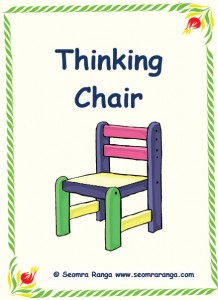Providing positive reinforcement to students who are following rules and procedures and providing appropriate responses to students who are not following rules and procedures in the early learning classrooms
Developmental Preschool Classroom Rules and Consequences
An example of how I would
deal with a student requiring discipline:
When / if a student requires
discipline, my colleagues and I will use the following procedure unless a student
has a specific behavior plan. We want our students to be responsible,
respectful and safe.
·
First time – Teacher
/ I will talk to the student and give him or her a reminder / redirection
· Second time -
warning and verbal reminder (on the behavior chart, his / her stick moves to
yellow on the stoplight)
· Third time -
Time out (thinking chair) and stick moves to red on stoplight. The student will sit away from the other
children and parents are notified by a note or phone call
On the other hand, if a student chooses to follow instructions the first time, I will praise him / her by using the “Speaking in three-part messages” technique, which is an effective tool for keeping the teacher’s focus on the student’s behavior. This three-part, non-blaming statement helps a young student to hear which behaviors are not acceptable without damaging his / her social, emotional, or cognitive development.
This positive reinforcement system encourages a student to repeat desired behavior and will tend to stimulate intrinsic motivation. When a student sees or hears a classmate being reinforced for a particular behavior, the attention given to the targeted behavior increases the odds that the disruptive student will be motivated to try the same behavior.
Example
2 deals with a student with aggressive behavior:
Aggressive
behavior such as hitting, kicking, biting or throwing things at others will
result in an automatic timeout. If
needed, the child will be removed from the classroom to calm down and his / her
parents will be notified.
However,
the “Speaking in three-part messages” technique can also be adapted here, to
extinguish disruptive behavior:
“John,
when I see you snatching the ball from Mary, I get so sad that I am going to
keep you with me until I think you understand about being gentle and sharing
with others”.
This technique also allows a student to think about their behavior and choices. Students need the opportunity to connect their behavior and its consequences. Using logical consequences allows students to learn from their experience. This will encourage self-direction and intrinsic motivation.
This flowchart illustrates my decision making process for both of the discussed examples.
References:
(Accessed on 04 May 2015)
http://www.scholastic.com/teachers/article/30-classroom-procedures-head-behavior-problems
http://www.childcarequarterly.com/pdf/spring09_selfcontrol.pdf




No comments:
Post a Comment